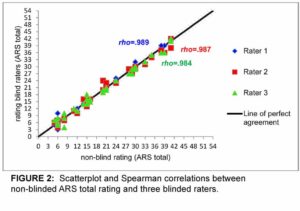 Frontiers in Psychiatry, August 2020, Volume 11, 730, pp. 1-12
Frontiers in Psychiatry, August 2020, Volume 11, 730, pp. 1-12
An oligoantigenic diet is a few-foods diet, used sometimes to identify foods a child may be allergic to. It excludes all the food dyes, preservatives, and other additives, as well as a large number of foods such as eggs, milk, wheat, etc. Sometimes it also excludes the salicylates, depending on whether the fruits allowed include apples or only pears. Basically, it could be called an extreme Feingold-type diet.
The graph above does not indicate the outcome of the diet, but rather the ability of the raters to agree with each other on the outcome of the diet.
Results:
- The raters and the videos used were in good agreement
- 60% of the children showed a significant improvement in ADHD symptoms after 4 weeks on the diet
- This confirms the “hypothesis that food intolerances are a possible cause of ADHD.”




















